Supply Chain Management in Tesco
VerifiedAdded on 2020/04/21
|18
|2958
|357
AI Summary
This assignment delves into the complexities of supply chain management within the retail giant Tesco. It examines various aspects of their operations, including risk management strategies employed to mitigate potential disruptions, the integration of sustainable practices across their supply network, and key performance indicators used to evaluate the effectiveness of their supply chain. The analysis draws upon academic research, industry reports, and publicly available information about Tesco's policies and practices.
Contribute Materials
Your contribution can guide someone’s learning journey. Share your
documents today.
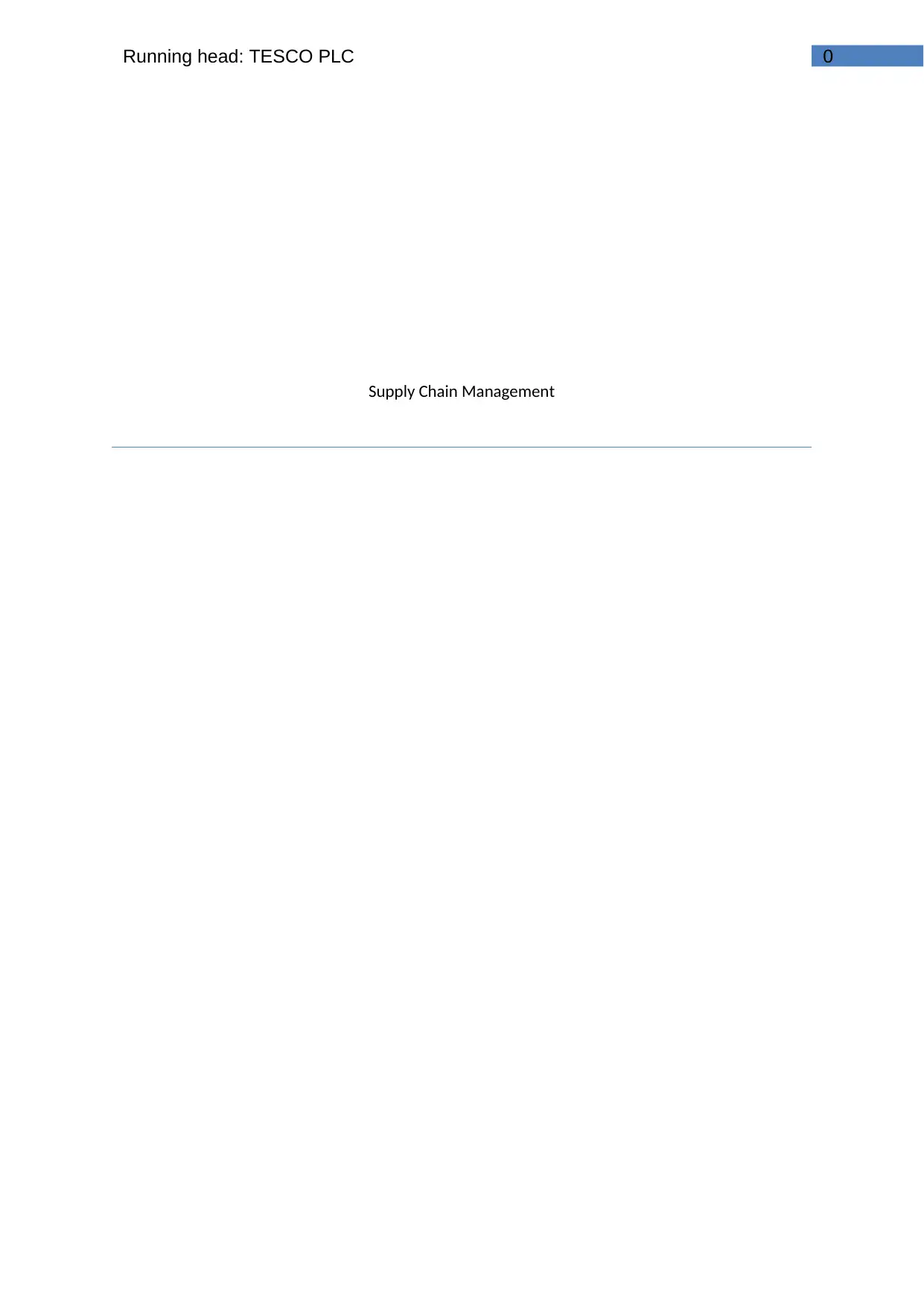
0Running head: TESCO PLC
Supply Chain Management
Supply Chain Management
Secure Best Marks with AI Grader
Need help grading? Try our AI Grader for instant feedback on your assignments.
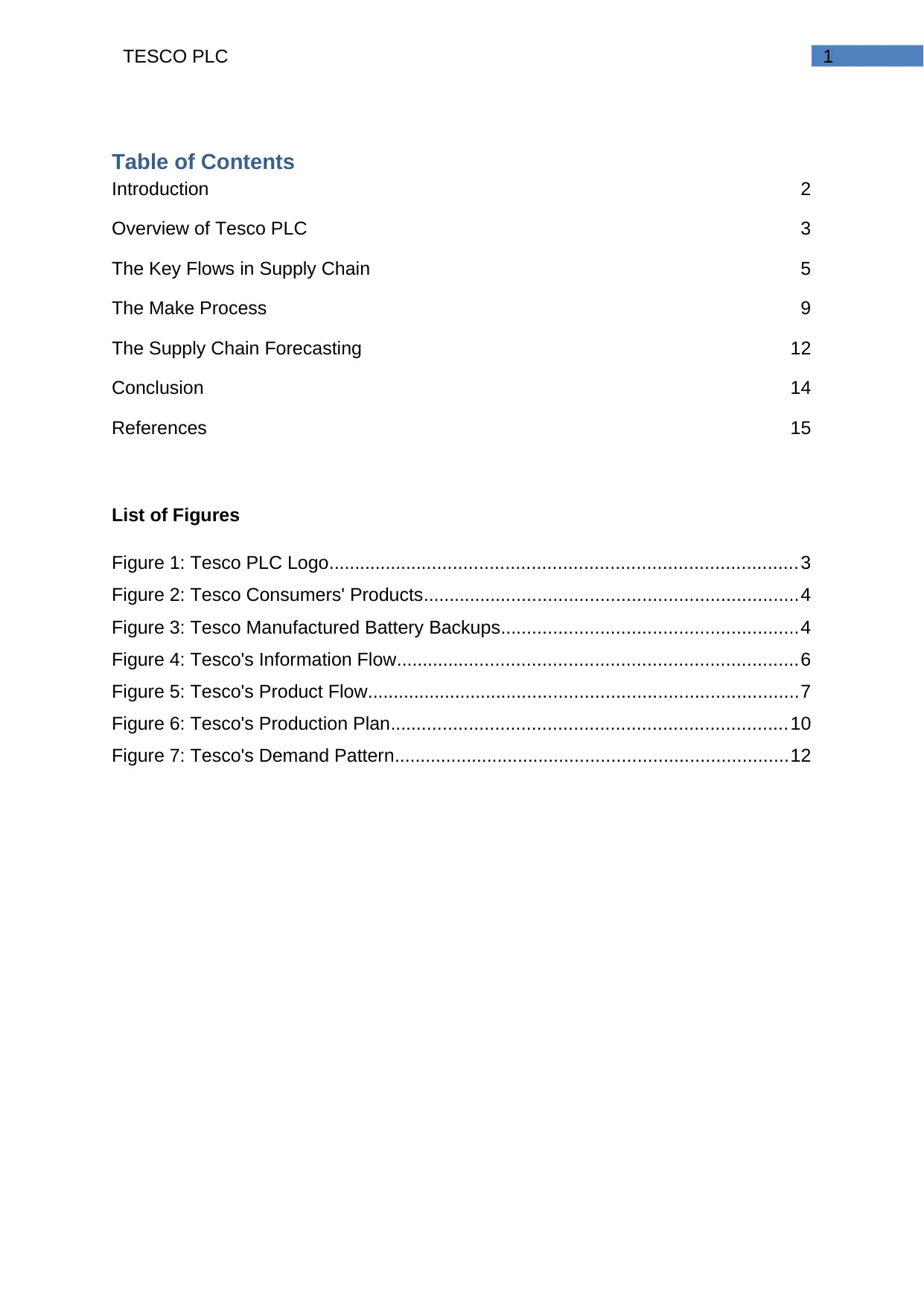
1TESCO PLC
Table of Contents
Introduction 2
Overview of Tesco PLC 3
The Key Flows in Supply Chain 5
The Make Process 9
The Supply Chain Forecasting 12
Conclusion 14
References 15
List of Figures
Figure 1: Tesco PLC Logo..........................................................................................3
Figure 2: Tesco Consumers' Products........................................................................4
Figure 3: Tesco Manufactured Battery Backups.........................................................4
Figure 4: Tesco's Information Flow.............................................................................6
Figure 5: Tesco's Product Flow...................................................................................7
Figure 6: Tesco's Production Plan............................................................................10
Figure 7: Tesco's Demand Pattern............................................................................12
Table of Contents
Introduction 2
Overview of Tesco PLC 3
The Key Flows in Supply Chain 5
The Make Process 9
The Supply Chain Forecasting 12
Conclusion 14
References 15
List of Figures
Figure 1: Tesco PLC Logo..........................................................................................3
Figure 2: Tesco Consumers' Products........................................................................4
Figure 3: Tesco Manufactured Battery Backups.........................................................4
Figure 4: Tesco's Information Flow.............................................................................6
Figure 5: Tesco's Product Flow...................................................................................7
Figure 6: Tesco's Production Plan............................................................................10
Figure 7: Tesco's Demand Pattern............................................................................12
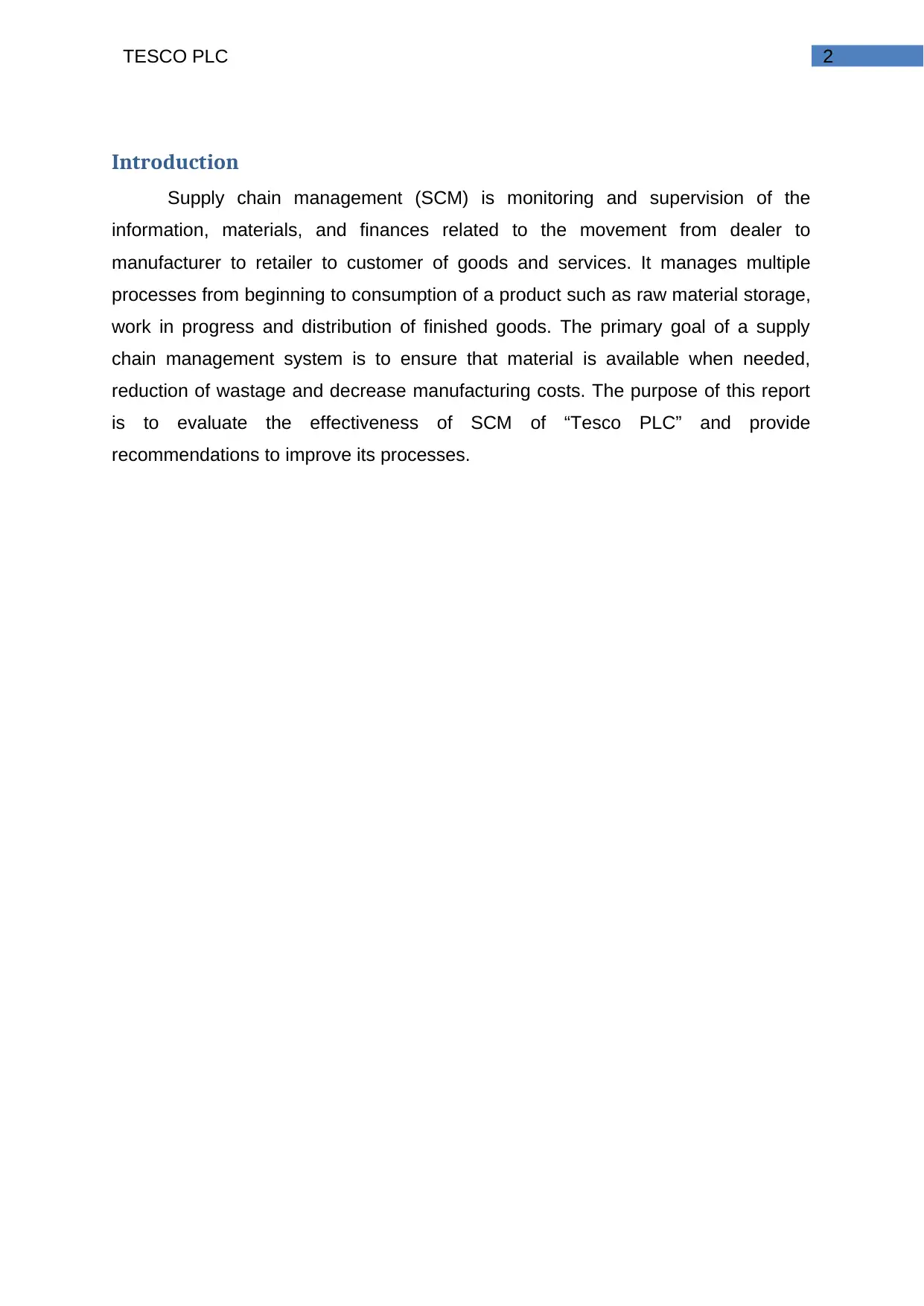
2TESCO PLC
Introduction
Supply chain management (SCM) is monitoring and supervision of the
information, materials, and finances related to the movement from dealer to
manufacturer to retailer to customer of goods and services. It manages multiple
processes from beginning to consumption of a product such as raw material storage,
work in progress and distribution of finished goods. The primary goal of a supply
chain management system is to ensure that material is available when needed,
reduction of wastage and decrease manufacturing costs. The purpose of this report
is to evaluate the effectiveness of SCM of “Tesco PLC” and provide
recommendations to improve its processes.
Introduction
Supply chain management (SCM) is monitoring and supervision of the
information, materials, and finances related to the movement from dealer to
manufacturer to retailer to customer of goods and services. It manages multiple
processes from beginning to consumption of a product such as raw material storage,
work in progress and distribution of finished goods. The primary goal of a supply
chain management system is to ensure that material is available when needed,
reduction of wastage and decrease manufacturing costs. The purpose of this report
is to evaluate the effectiveness of SCM of “Tesco PLC” and provide
recommendations to improve its processes.
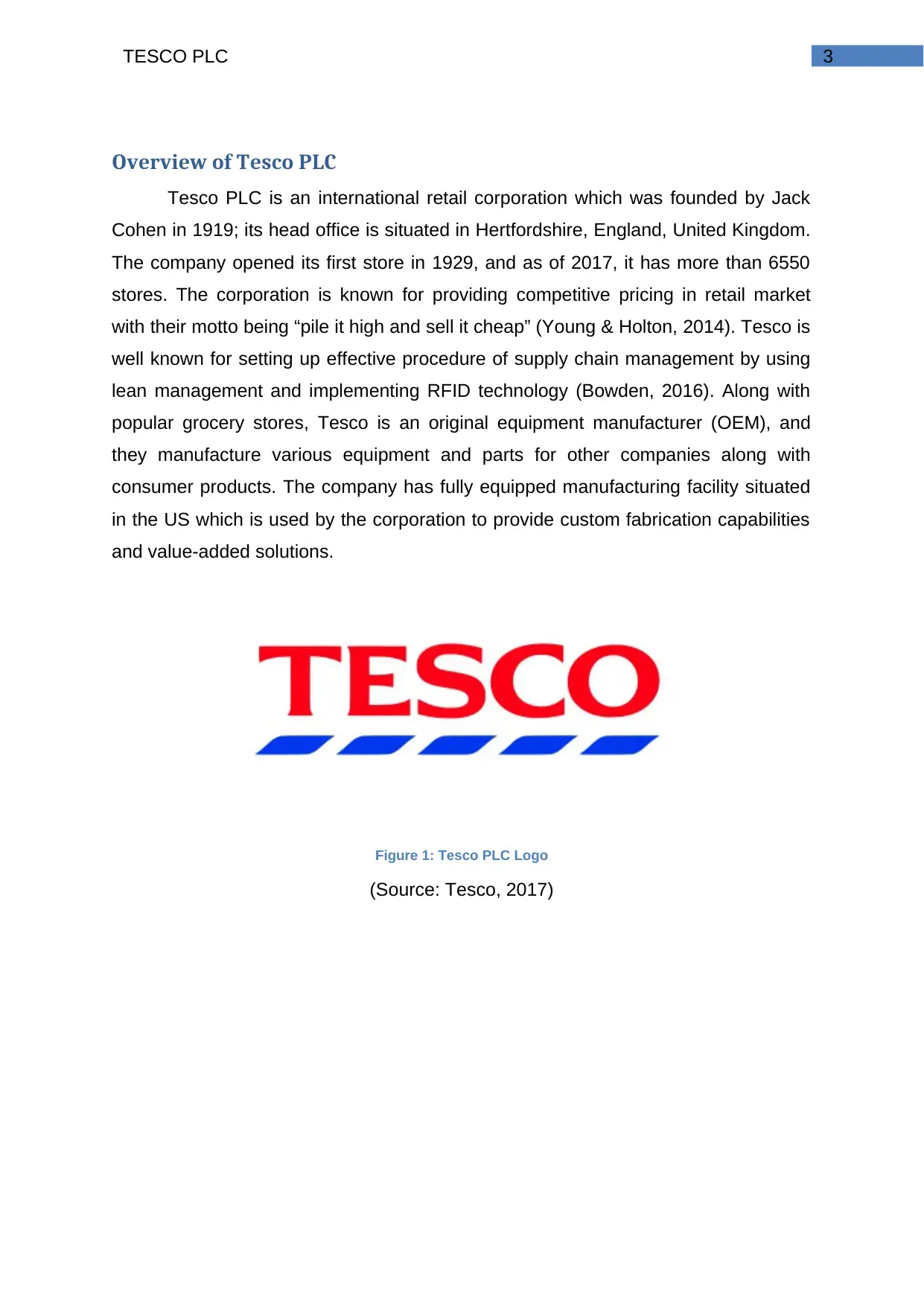
3TESCO PLC
Overview of Tesco PLC
Tesco PLC is an international retail corporation which was founded by Jack
Cohen in 1919; its head office is situated in Hertfordshire, England, United Kingdom.
The company opened its first store in 1929, and as of 2017, it has more than 6550
stores. The corporation is known for providing competitive pricing in retail market
with their motto being “pile it high and sell it cheap” (Young & Holton, 2014). Tesco is
well known for setting up effective procedure of supply chain management by using
lean management and implementing RFID technology (Bowden, 2016). Along with
popular grocery stores, Tesco is an original equipment manufacturer (OEM), and
they manufacture various equipment and parts for other companies along with
consumer products. The company has fully equipped manufacturing facility situated
in the US which is used by the corporation to provide custom fabrication capabilities
and value-added solutions.
Figure 1: Tesco PLC Logo
(Source: Tesco, 2017)
Overview of Tesco PLC
Tesco PLC is an international retail corporation which was founded by Jack
Cohen in 1919; its head office is situated in Hertfordshire, England, United Kingdom.
The company opened its first store in 1929, and as of 2017, it has more than 6550
stores. The corporation is known for providing competitive pricing in retail market
with their motto being “pile it high and sell it cheap” (Young & Holton, 2014). Tesco is
well known for setting up effective procedure of supply chain management by using
lean management and implementing RFID technology (Bowden, 2016). Along with
popular grocery stores, Tesco is an original equipment manufacturer (OEM), and
they manufacture various equipment and parts for other companies along with
consumer products. The company has fully equipped manufacturing facility situated
in the US which is used by the corporation to provide custom fabrication capabilities
and value-added solutions.
Figure 1: Tesco PLC Logo
(Source: Tesco, 2017)
Secure Best Marks with AI Grader
Need help grading? Try our AI Grader for instant feedback on your assignments.
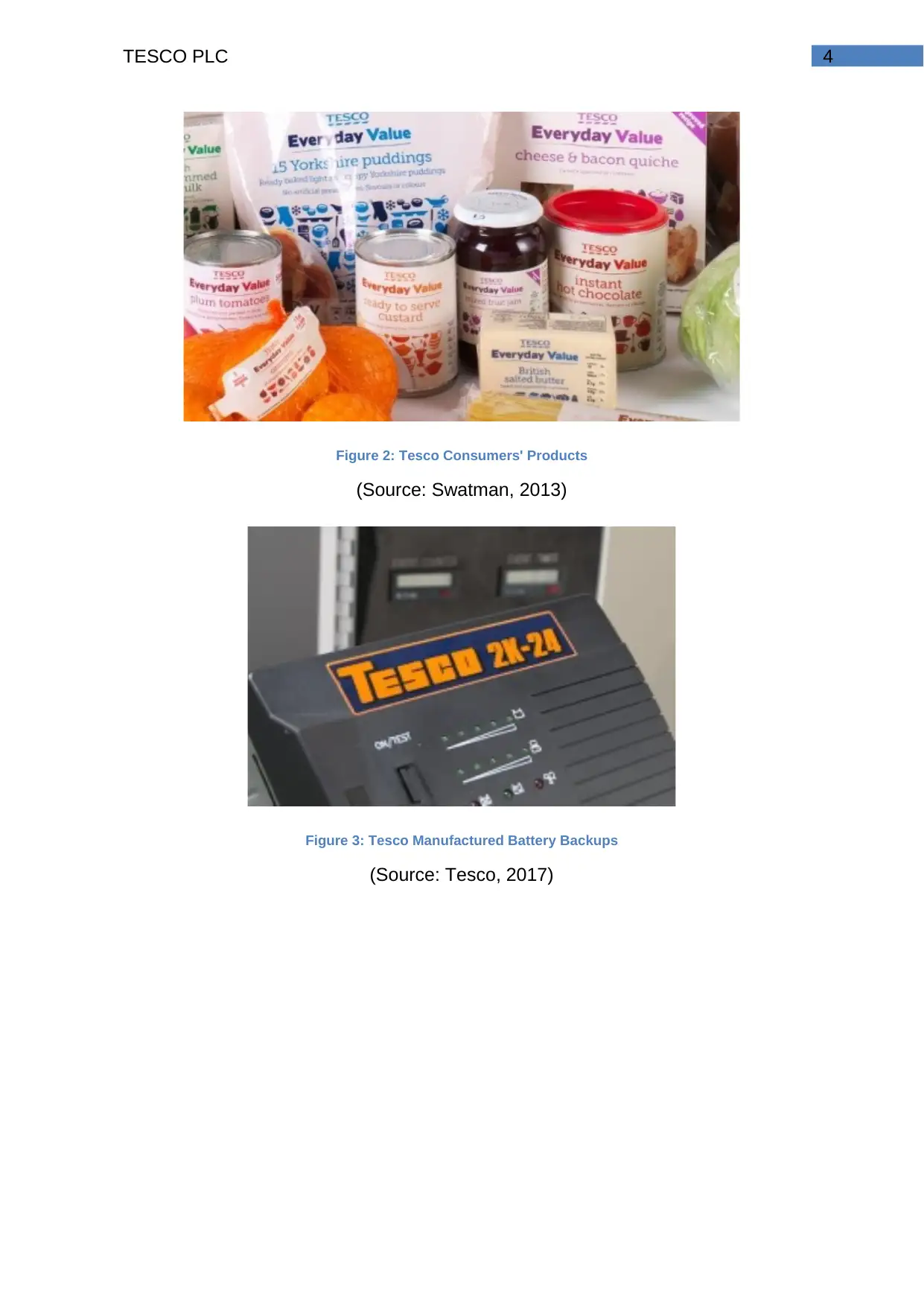
4TESCO PLC
Figure 2: Tesco Consumers' Products
(Source: Swatman, 2013)
Figure 3: Tesco Manufactured Battery Backups
(Source: Tesco, 2017)
Figure 2: Tesco Consumers' Products
(Source: Swatman, 2013)
Figure 3: Tesco Manufactured Battery Backups
(Source: Tesco, 2017)
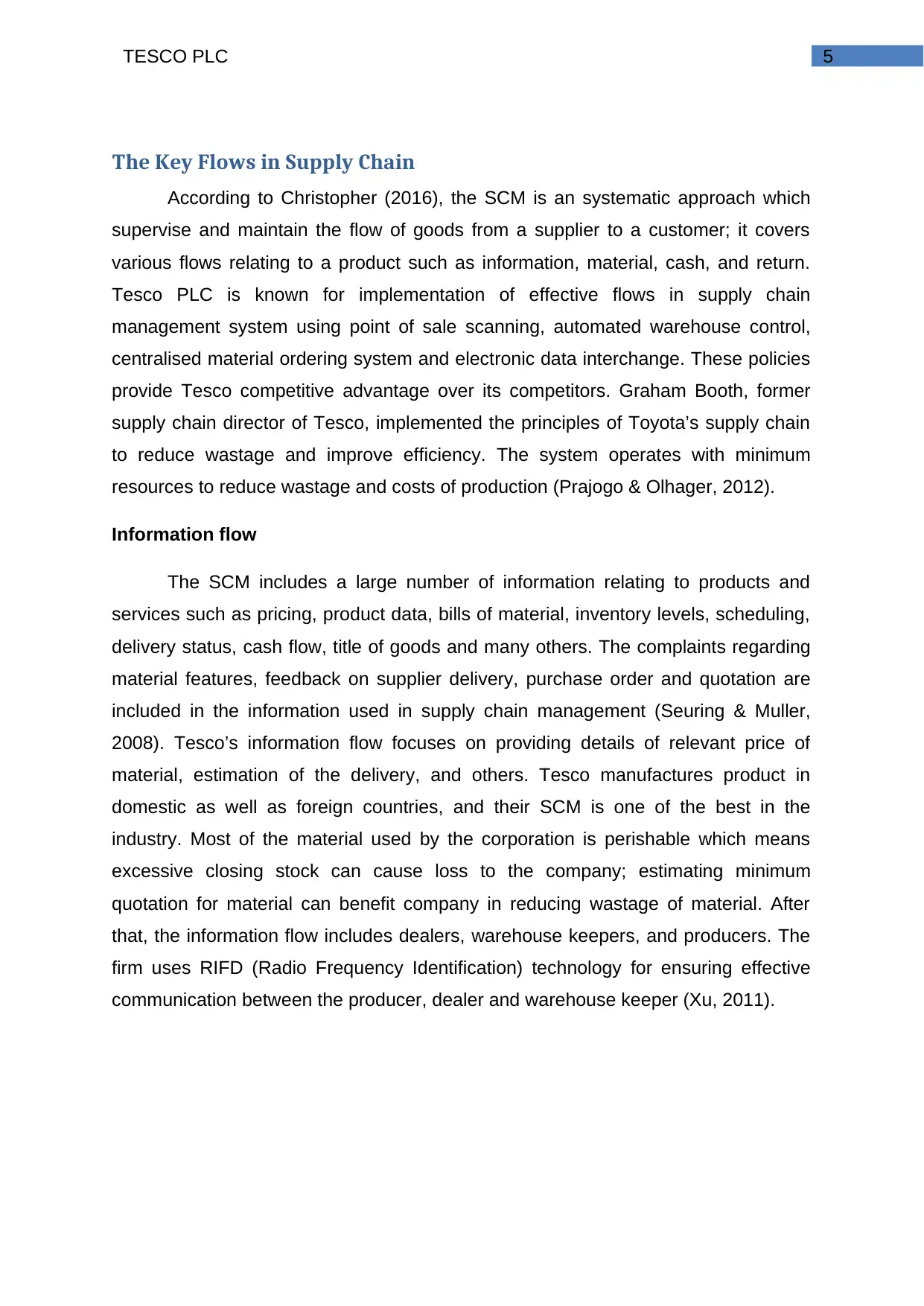
5TESCO PLC
The Key Flows in Supply Chain
According to Christopher (2016), the SCM is an systematic approach which
supervise and maintain the flow of goods from a supplier to a customer; it covers
various flows relating to a product such as information, material, cash, and return.
Tesco PLC is known for implementation of effective flows in supply chain
management system using point of sale scanning, automated warehouse control,
centralised material ordering system and electronic data interchange. These policies
provide Tesco competitive advantage over its competitors. Graham Booth, former
supply chain director of Tesco, implemented the principles of Toyota’s supply chain
to reduce wastage and improve efficiency. The system operates with minimum
resources to reduce wastage and costs of production (Prajogo & Olhager, 2012).
Information flow
The SCM includes a large number of information relating to products and
services such as pricing, product data, bills of material, inventory levels, scheduling,
delivery status, cash flow, title of goods and many others. The complaints regarding
material features, feedback on supplier delivery, purchase order and quotation are
included in the information used in supply chain management (Seuring & Muller,
2008). Tesco’s information flow focuses on providing details of relevant price of
material, estimation of the delivery, and others. Tesco manufactures product in
domestic as well as foreign countries, and their SCM is one of the best in the
industry. Most of the material used by the corporation is perishable which means
excessive closing stock can cause loss to the company; estimating minimum
quotation for material can benefit company in reducing wastage of material. After
that, the information flow includes dealers, warehouse keepers, and producers. The
firm uses RIFD (Radio Frequency Identification) technology for ensuring effective
communication between the producer, dealer and warehouse keeper (Xu, 2011).
The Key Flows in Supply Chain
According to Christopher (2016), the SCM is an systematic approach which
supervise and maintain the flow of goods from a supplier to a customer; it covers
various flows relating to a product such as information, material, cash, and return.
Tesco PLC is known for implementation of effective flows in supply chain
management system using point of sale scanning, automated warehouse control,
centralised material ordering system and electronic data interchange. These policies
provide Tesco competitive advantage over its competitors. Graham Booth, former
supply chain director of Tesco, implemented the principles of Toyota’s supply chain
to reduce wastage and improve efficiency. The system operates with minimum
resources to reduce wastage and costs of production (Prajogo & Olhager, 2012).
Information flow
The SCM includes a large number of information relating to products and
services such as pricing, product data, bills of material, inventory levels, scheduling,
delivery status, cash flow, title of goods and many others. The complaints regarding
material features, feedback on supplier delivery, purchase order and quotation are
included in the information used in supply chain management (Seuring & Muller,
2008). Tesco’s information flow focuses on providing details of relevant price of
material, estimation of the delivery, and others. Tesco manufactures product in
domestic as well as foreign countries, and their SCM is one of the best in the
industry. Most of the material used by the corporation is perishable which means
excessive closing stock can cause loss to the company; estimating minimum
quotation for material can benefit company in reducing wastage of material. After
that, the information flow includes dealers, warehouse keepers, and producers. The
firm uses RIFD (Radio Frequency Identification) technology for ensuring effective
communication between the producer, dealer and warehouse keeper (Xu, 2011).
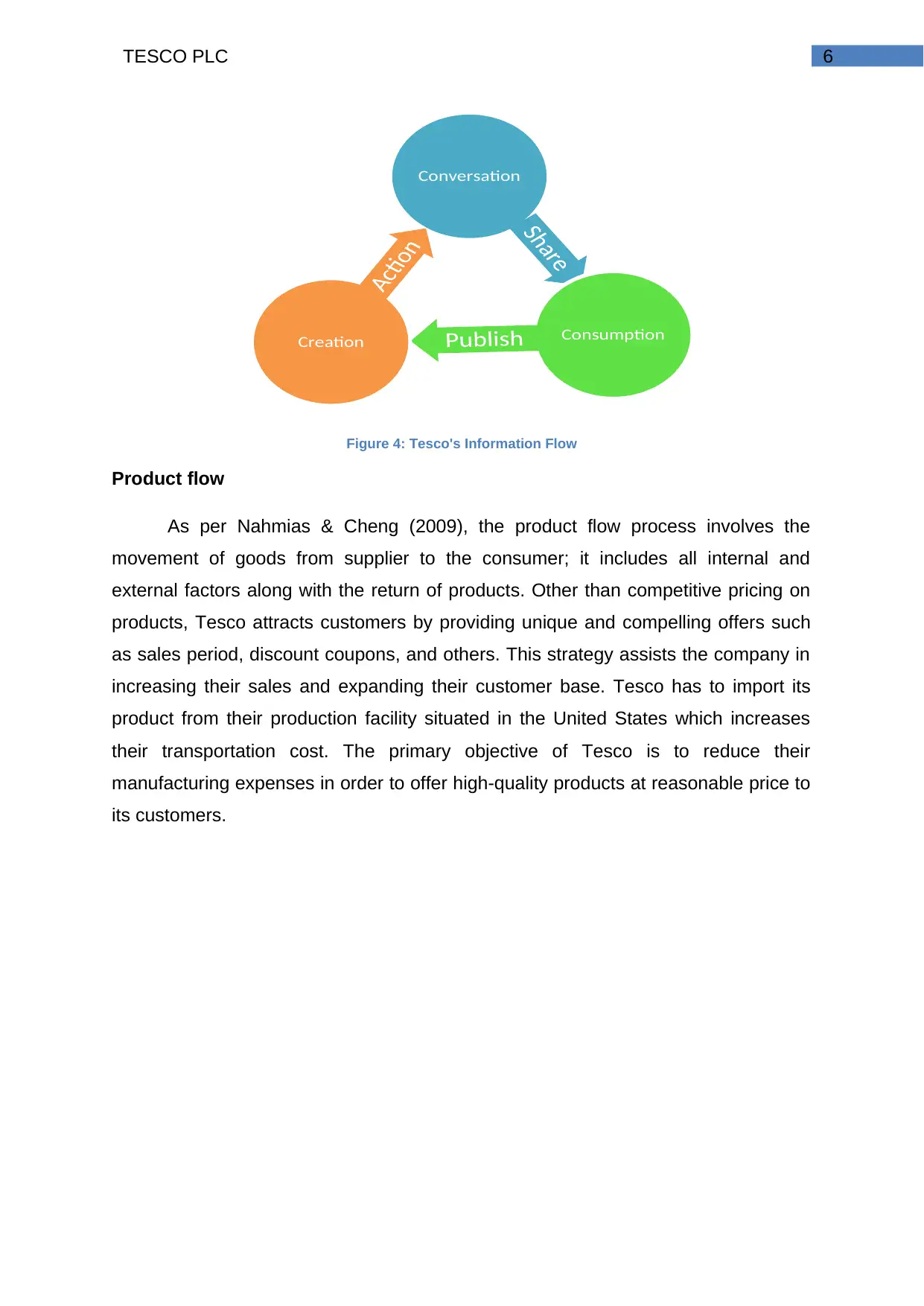
6TESCO PLC
Figure 4: Tesco's Information Flow
Product flow
As per Nahmias & Cheng (2009), the product flow process involves the
movement of goods from supplier to the consumer; it includes all internal and
external factors along with the return of products. Other than competitive pricing on
products, Tesco attracts customers by providing unique and compelling offers such
as sales period, discount coupons, and others. This strategy assists the company in
increasing their sales and expanding their customer base. Tesco has to import its
product from their production facility situated in the United States which increases
their transportation cost. The primary objective of Tesco is to reduce their
manufacturing expenses in order to offer high-quality products at reasonable price to
its customers.
Conversation
ConsumptionCreation
Figure 4: Tesco's Information Flow
Product flow
As per Nahmias & Cheng (2009), the product flow process involves the
movement of goods from supplier to the consumer; it includes all internal and
external factors along with the return of products. Other than competitive pricing on
products, Tesco attracts customers by providing unique and compelling offers such
as sales period, discount coupons, and others. This strategy assists the company in
increasing their sales and expanding their customer base. Tesco has to import its
product from their production facility situated in the United States which increases
their transportation cost. The primary objective of Tesco is to reduce their
manufacturing expenses in order to offer high-quality products at reasonable price to
its customers.
Conversation
ConsumptionCreation
Paraphrase This Document
Need a fresh take? Get an instant paraphrase of this document with our AI Paraphraser
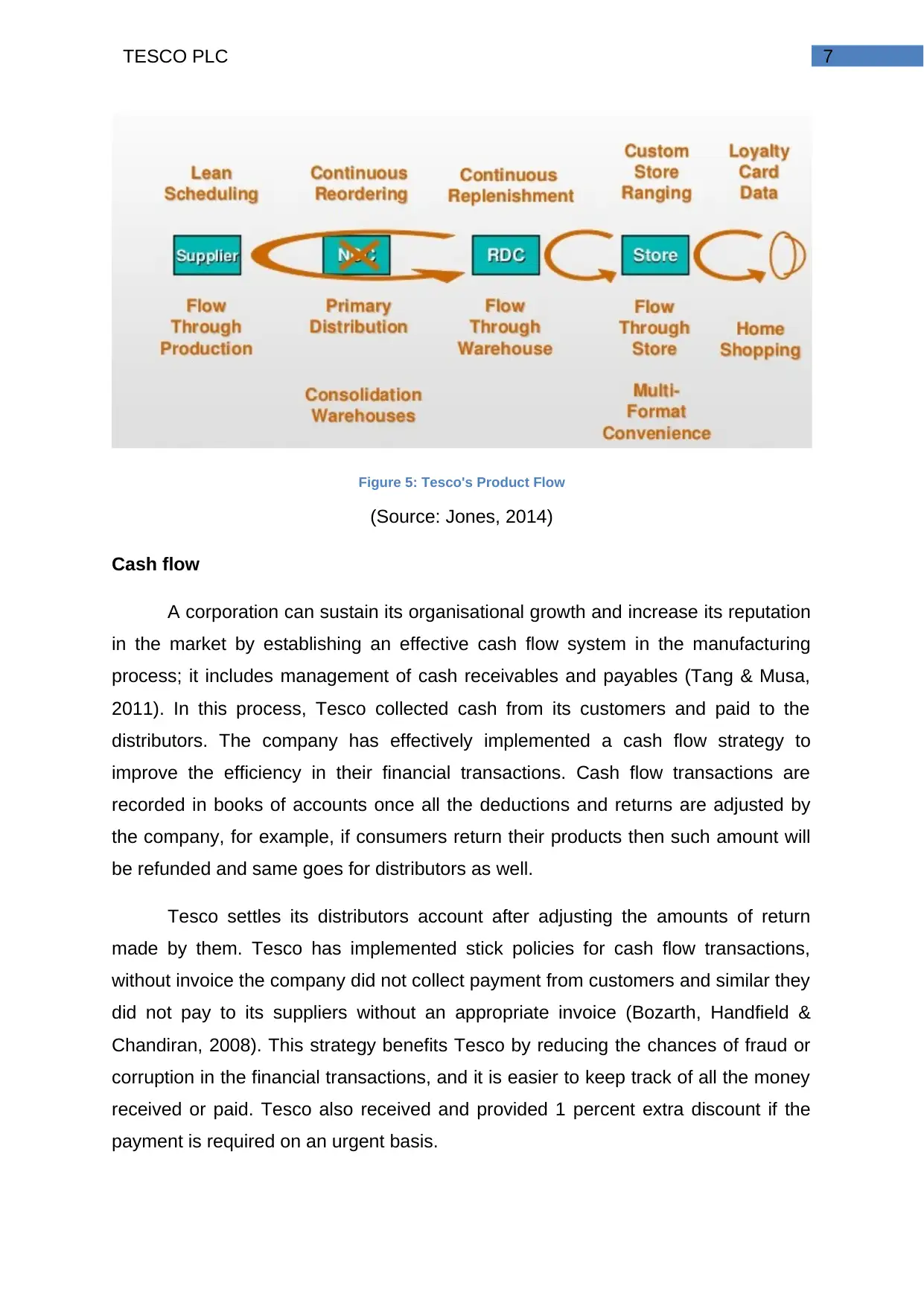
7TESCO PLC
Figure 5: Tesco's Product Flow
(Source: Jones, 2014)
Cash flow
A corporation can sustain its organisational growth and increase its reputation
in the market by establishing an effective cash flow system in the manufacturing
process; it includes management of cash receivables and payables (Tang & Musa,
2011). In this process, Tesco collected cash from its customers and paid to the
distributors. The company has effectively implemented a cash flow strategy to
improve the efficiency in their financial transactions. Cash flow transactions are
recorded in books of accounts once all the deductions and returns are adjusted by
the company, for example, if consumers return their products then such amount will
be refunded and same goes for distributors as well.
Tesco settles its distributors account after adjusting the amounts of return
made by them. Tesco has implemented stick policies for cash flow transactions,
without invoice the company did not collect payment from customers and similar they
did not pay to its suppliers without an appropriate invoice (Bozarth, Handfield &
Chandiran, 2008). This strategy benefits Tesco by reducing the chances of fraud or
corruption in the financial transactions, and it is easier to keep track of all the money
received or paid. Tesco also received and provided 1 percent extra discount if the
payment is required on an urgent basis.
Figure 5: Tesco's Product Flow
(Source: Jones, 2014)
Cash flow
A corporation can sustain its organisational growth and increase its reputation
in the market by establishing an effective cash flow system in the manufacturing
process; it includes management of cash receivables and payables (Tang & Musa,
2011). In this process, Tesco collected cash from its customers and paid to the
distributors. The company has effectively implemented a cash flow strategy to
improve the efficiency in their financial transactions. Cash flow transactions are
recorded in books of accounts once all the deductions and returns are adjusted by
the company, for example, if consumers return their products then such amount will
be refunded and same goes for distributors as well.
Tesco settles its distributors account after adjusting the amounts of return
made by them. Tesco has implemented stick policies for cash flow transactions,
without invoice the company did not collect payment from customers and similar they
did not pay to its suppliers without an appropriate invoice (Bozarth, Handfield &
Chandiran, 2008). This strategy benefits Tesco by reducing the chances of fraud or
corruption in the financial transactions, and it is easier to keep track of all the money
received or paid. Tesco also received and provided 1 percent extra discount if the
payment is required on an urgent basis.
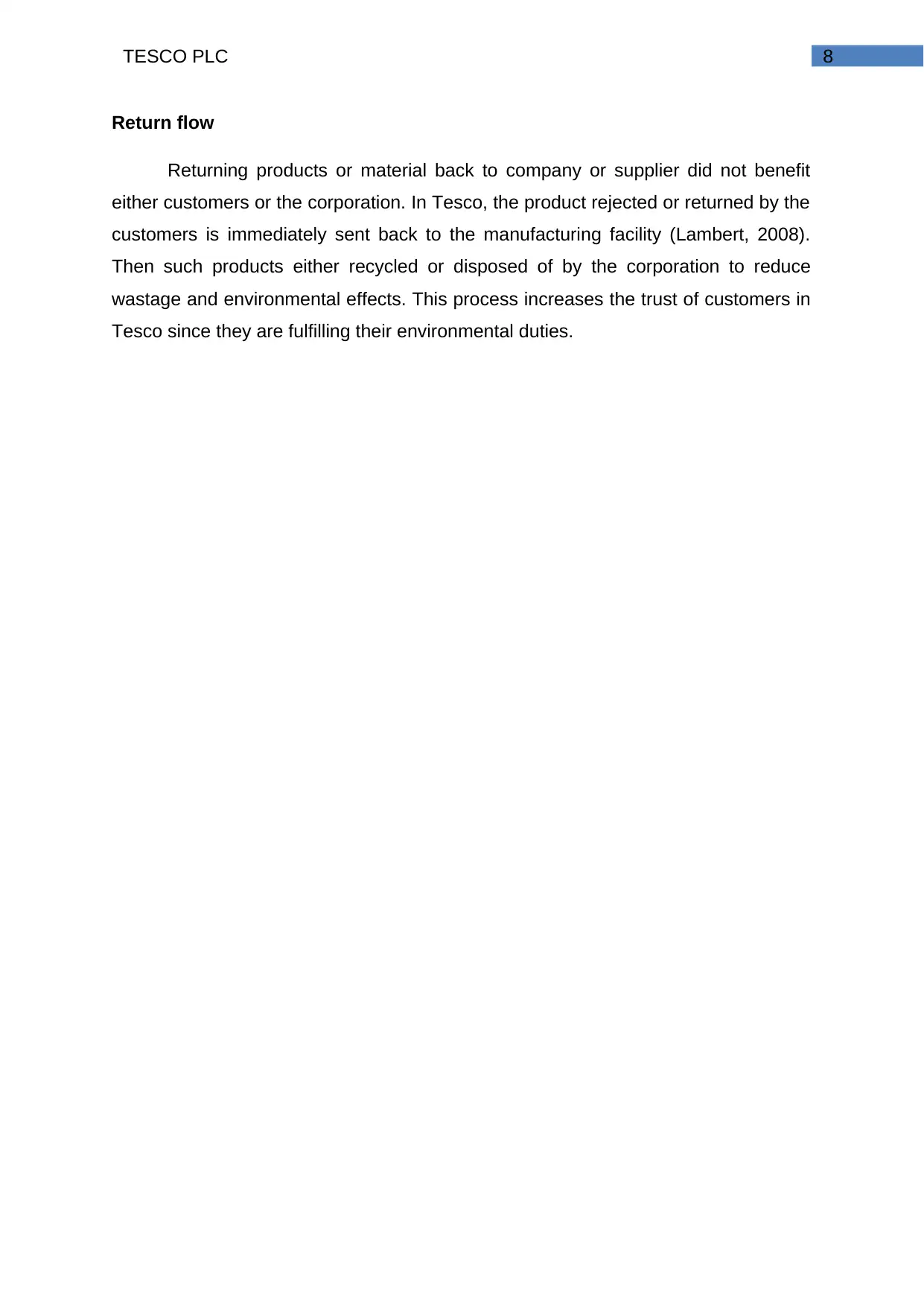
8TESCO PLC
Return flow
Returning products or material back to company or supplier did not benefit
either customers or the corporation. In Tesco, the product rejected or returned by the
customers is immediately sent back to the manufacturing facility (Lambert, 2008).
Then such products either recycled or disposed of by the corporation to reduce
wastage and environmental effects. This process increases the trust of customers in
Tesco since they are fulfilling their environmental duties.
Return flow
Returning products or material back to company or supplier did not benefit
either customers or the corporation. In Tesco, the product rejected or returned by the
customers is immediately sent back to the manufacturing facility (Lambert, 2008).
Then such products either recycled or disposed of by the corporation to reduce
wastage and environmental effects. This process increases the trust of customers in
Tesco since they are fulfilling their environmental duties.
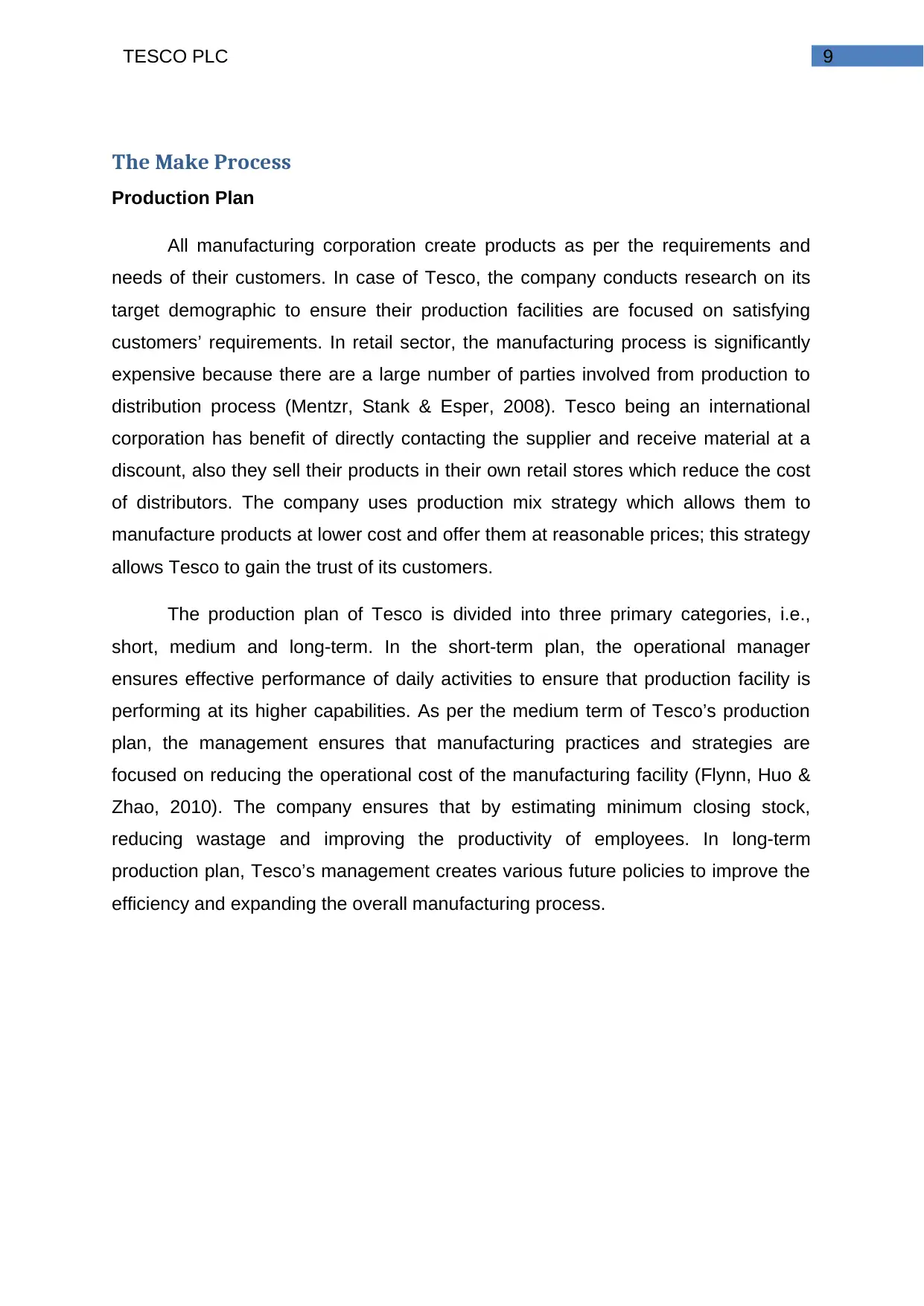
9TESCO PLC
The Make Process
Production Plan
All manufacturing corporation create products as per the requirements and
needs of their customers. In case of Tesco, the company conducts research on its
target demographic to ensure their production facilities are focused on satisfying
customers’ requirements. In retail sector, the manufacturing process is significantly
expensive because there are a large number of parties involved from production to
distribution process (Mentzr, Stank & Esper, 2008). Tesco being an international
corporation has benefit of directly contacting the supplier and receive material at a
discount, also they sell their products in their own retail stores which reduce the cost
of distributors. The company uses production mix strategy which allows them to
manufacture products at lower cost and offer them at reasonable prices; this strategy
allows Tesco to gain the trust of its customers.
The production plan of Tesco is divided into three primary categories, i.e.,
short, medium and long-term. In the short-term plan, the operational manager
ensures effective performance of daily activities to ensure that production facility is
performing at its higher capabilities. As per the medium term of Tesco’s production
plan, the management ensures that manufacturing practices and strategies are
focused on reducing the operational cost of the manufacturing facility (Flynn, Huo &
Zhao, 2010). The company ensures that by estimating minimum closing stock,
reducing wastage and improving the productivity of employees. In long-term
production plan, Tesco’s management creates various future policies to improve the
efficiency and expanding the overall manufacturing process.
The Make Process
Production Plan
All manufacturing corporation create products as per the requirements and
needs of their customers. In case of Tesco, the company conducts research on its
target demographic to ensure their production facilities are focused on satisfying
customers’ requirements. In retail sector, the manufacturing process is significantly
expensive because there are a large number of parties involved from production to
distribution process (Mentzr, Stank & Esper, 2008). Tesco being an international
corporation has benefit of directly contacting the supplier and receive material at a
discount, also they sell their products in their own retail stores which reduce the cost
of distributors. The company uses production mix strategy which allows them to
manufacture products at lower cost and offer them at reasonable prices; this strategy
allows Tesco to gain the trust of its customers.
The production plan of Tesco is divided into three primary categories, i.e.,
short, medium and long-term. In the short-term plan, the operational manager
ensures effective performance of daily activities to ensure that production facility is
performing at its higher capabilities. As per the medium term of Tesco’s production
plan, the management ensures that manufacturing practices and strategies are
focused on reducing the operational cost of the manufacturing facility (Flynn, Huo &
Zhao, 2010). The company ensures that by estimating minimum closing stock,
reducing wastage and improving the productivity of employees. In long-term
production plan, Tesco’s management creates various future policies to improve the
efficiency and expanding the overall manufacturing process.
Secure Best Marks with AI Grader
Need help grading? Try our AI Grader for instant feedback on your assignments.
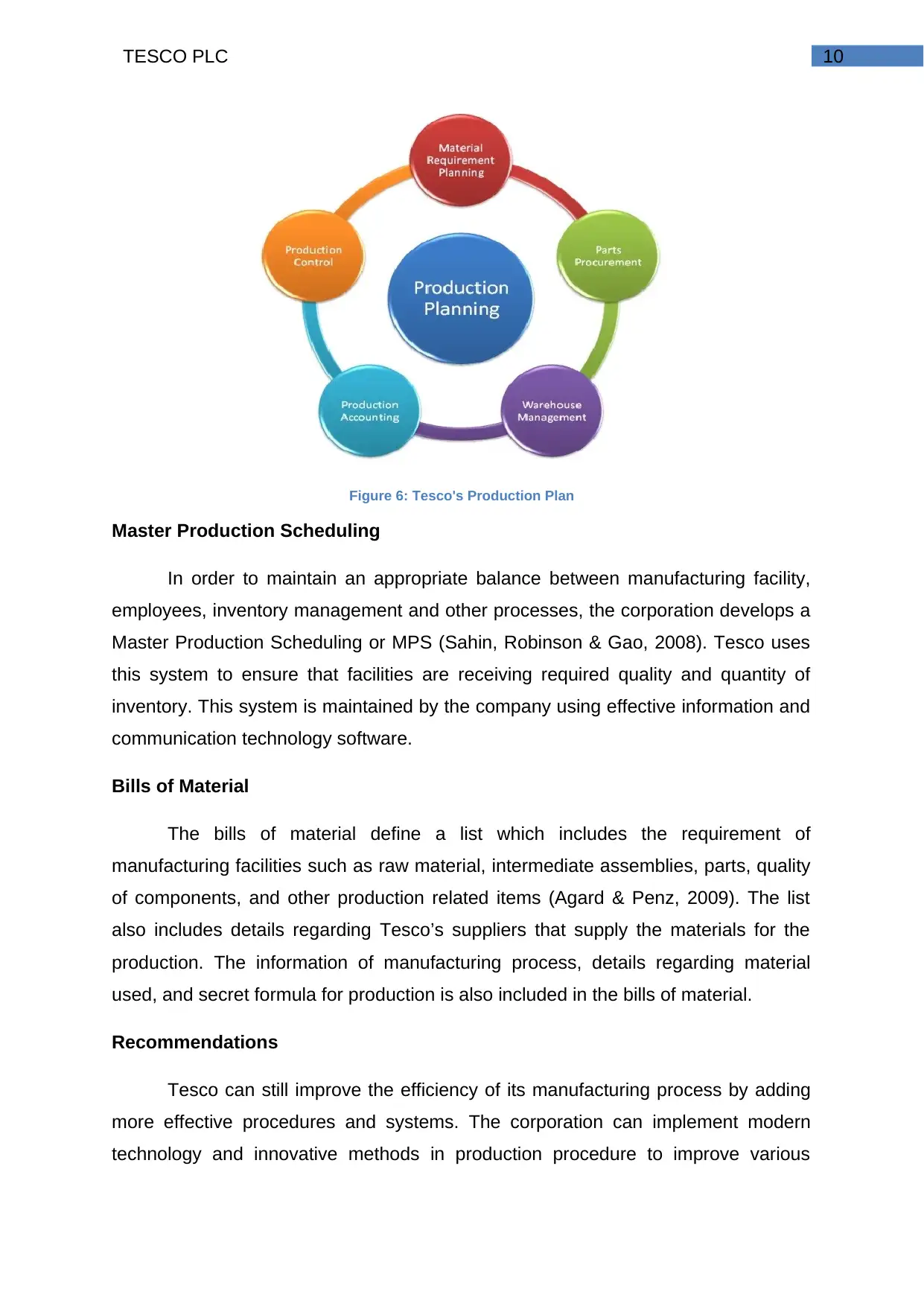
10TESCO PLC
Figure 6: Tesco's Production Plan
Master Production Scheduling
In order to maintain an appropriate balance between manufacturing facility,
employees, inventory management and other processes, the corporation develops a
Master Production Scheduling or MPS (Sahin, Robinson & Gao, 2008). Tesco uses
this system to ensure that facilities are receiving required quality and quantity of
inventory. This system is maintained by the company using effective information and
communication technology software.
Bills of Material
The bills of material define a list which includes the requirement of
manufacturing facilities such as raw material, intermediate assemblies, parts, quality
of components, and other production related items (Agard & Penz, 2009). The list
also includes details regarding Tesco’s suppliers that supply the materials for the
production. The information of manufacturing process, details regarding material
used, and secret formula for production is also included in the bills of material.
Recommendations
Tesco can still improve the efficiency of its manufacturing process by adding
more effective procedures and systems. The corporation can implement modern
technology and innovative methods in production procedure to improve various
Figure 6: Tesco's Production Plan
Master Production Scheduling
In order to maintain an appropriate balance between manufacturing facility,
employees, inventory management and other processes, the corporation develops a
Master Production Scheduling or MPS (Sahin, Robinson & Gao, 2008). Tesco uses
this system to ensure that facilities are receiving required quality and quantity of
inventory. This system is maintained by the company using effective information and
communication technology software.
Bills of Material
The bills of material define a list which includes the requirement of
manufacturing facilities such as raw material, intermediate assemblies, parts, quality
of components, and other production related items (Agard & Penz, 2009). The list
also includes details regarding Tesco’s suppliers that supply the materials for the
production. The information of manufacturing process, details regarding material
used, and secret formula for production is also included in the bills of material.
Recommendations
Tesco can still improve the efficiency of its manufacturing process by adding
more effective procedures and systems. The corporation can implement modern
technology and innovative methods in production procedure to improve various
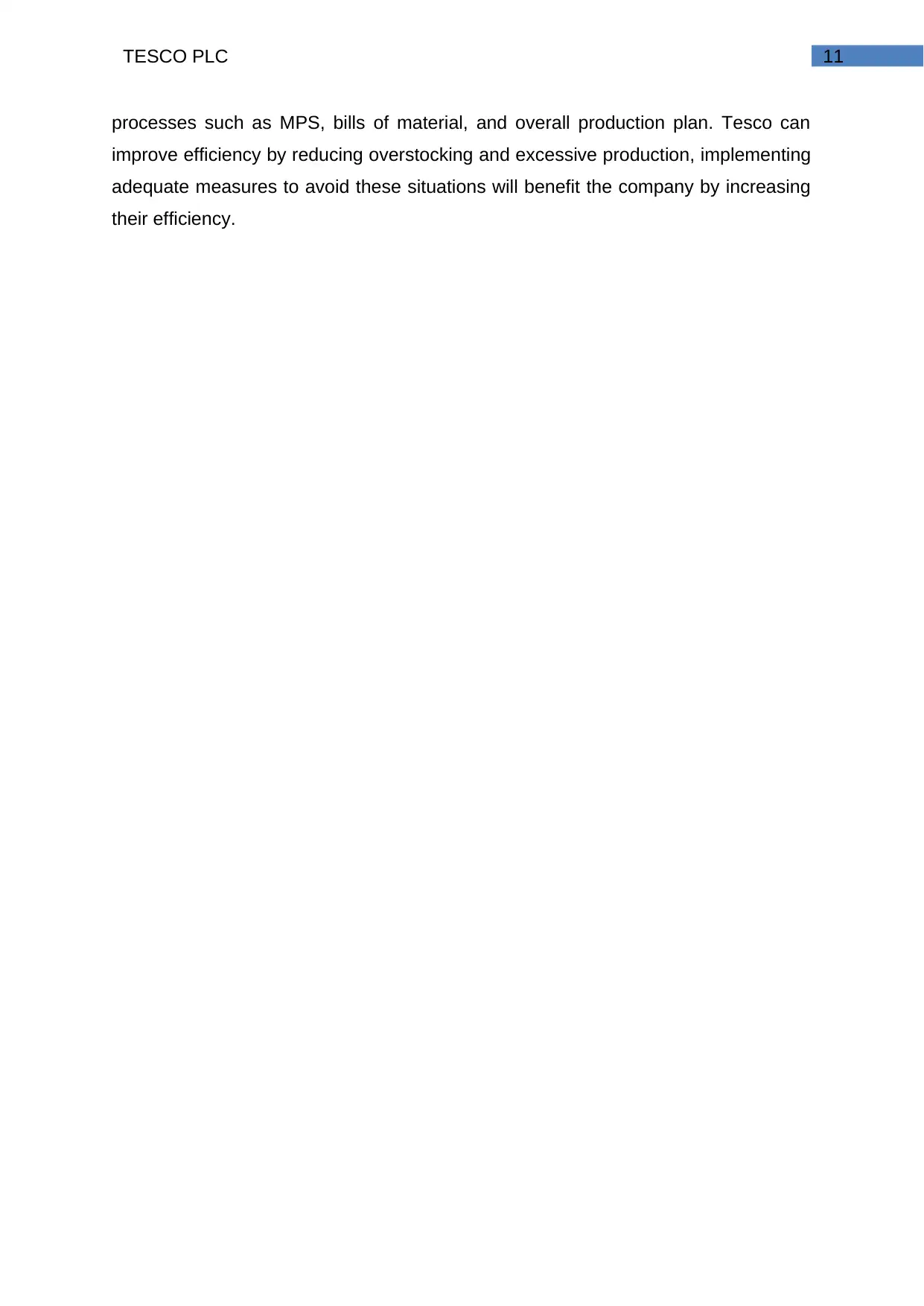
11TESCO PLC
processes such as MPS, bills of material, and overall production plan. Tesco can
improve efficiency by reducing overstocking and excessive production, implementing
adequate measures to avoid these situations will benefit the company by increasing
their efficiency.
processes such as MPS, bills of material, and overall production plan. Tesco can
improve efficiency by reducing overstocking and excessive production, implementing
adequate measures to avoid these situations will benefit the company by increasing
their efficiency.
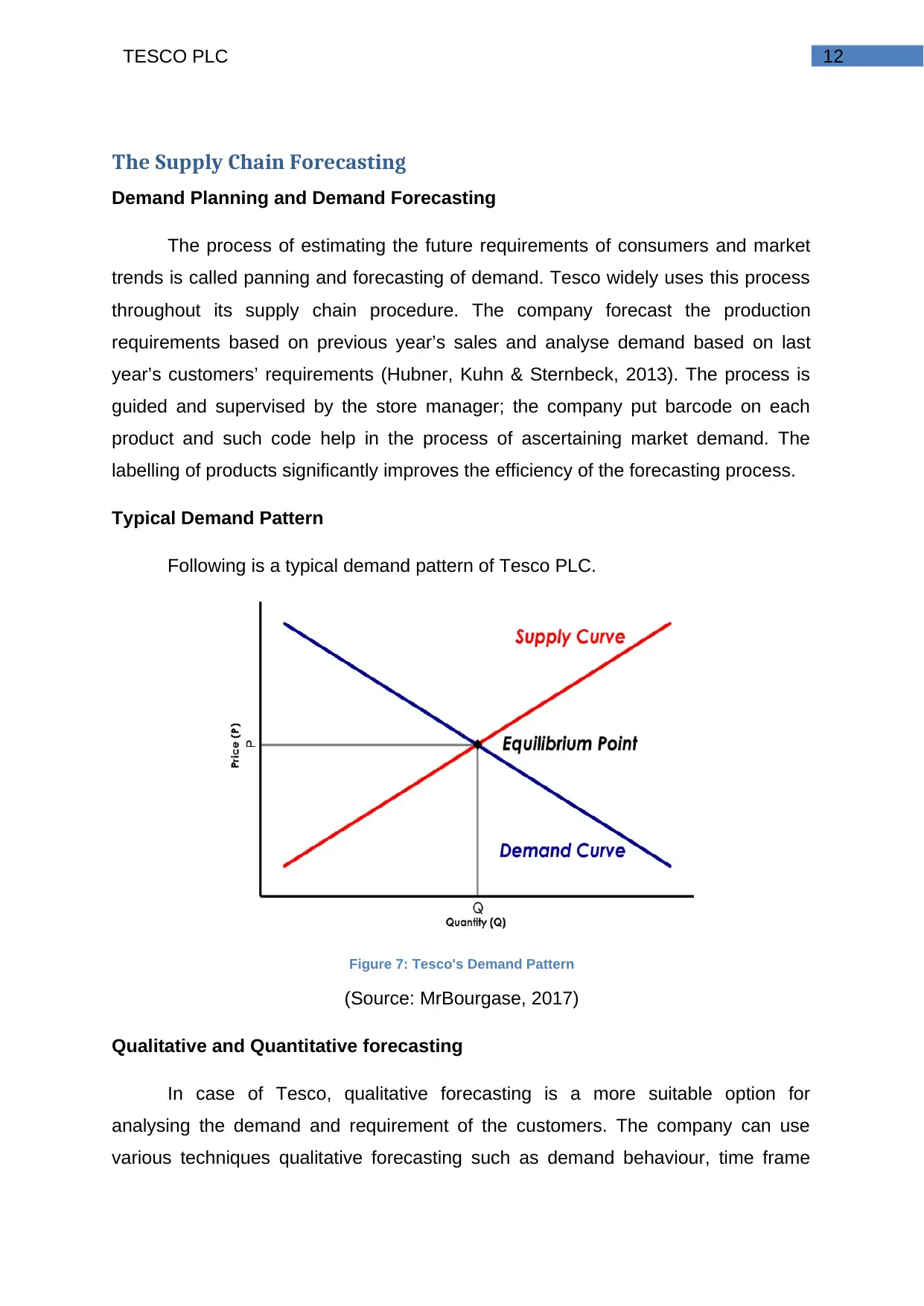
12TESCO PLC
The Supply Chain Forecasting
Demand Planning and Demand Forecasting
The process of estimating the future requirements of consumers and market
trends is called panning and forecasting of demand. Tesco widely uses this process
throughout its supply chain procedure. The company forecast the production
requirements based on previous year’s sales and analyse demand based on last
year’s customers’ requirements (Hubner, Kuhn & Sternbeck, 2013). The process is
guided and supervised by the store manager; the company put barcode on each
product and such code help in the process of ascertaining market demand. The
labelling of products significantly improves the efficiency of the forecasting process.
Typical Demand Pattern
Following is a typical demand pattern of Tesco PLC.
Figure 7: Tesco's Demand Pattern
(Source: MrBourgase, 2017)
Qualitative and Quantitative forecasting
In case of Tesco, qualitative forecasting is a more suitable option for
analysing the demand and requirement of the customers. The company can use
various techniques qualitative forecasting such as demand behaviour, time frame
The Supply Chain Forecasting
Demand Planning and Demand Forecasting
The process of estimating the future requirements of consumers and market
trends is called panning and forecasting of demand. Tesco widely uses this process
throughout its supply chain procedure. The company forecast the production
requirements based on previous year’s sales and analyse demand based on last
year’s customers’ requirements (Hubner, Kuhn & Sternbeck, 2013). The process is
guided and supervised by the store manager; the company put barcode on each
product and such code help in the process of ascertaining market demand. The
labelling of products significantly improves the efficiency of the forecasting process.
Typical Demand Pattern
Following is a typical demand pattern of Tesco PLC.
Figure 7: Tesco's Demand Pattern
(Source: MrBourgase, 2017)
Qualitative and Quantitative forecasting
In case of Tesco, qualitative forecasting is a more suitable option for
analysing the demand and requirement of the customers. The company can use
various techniques qualitative forecasting such as demand behaviour, time frame
Paraphrase This Document
Need a fresh take? Get an instant paraphrase of this document with our AI Paraphraser
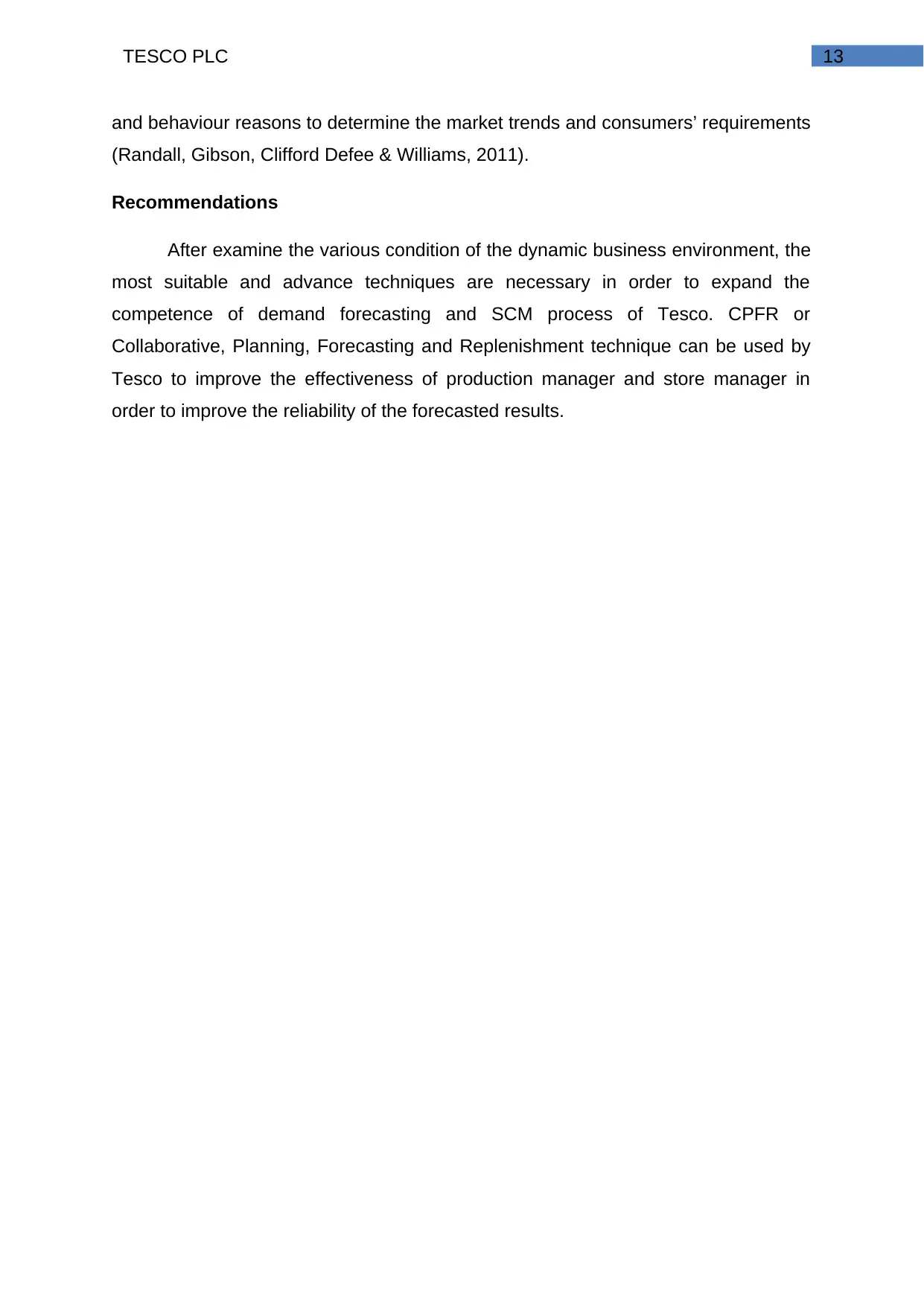
13TESCO PLC
and behaviour reasons to determine the market trends and consumers’ requirements
(Randall, Gibson, Clifford Defee & Williams, 2011).
Recommendations
After examine the various condition of the dynamic business environment, the
most suitable and advance techniques are necessary in order to expand the
competence of demand forecasting and SCM process of Tesco. CPFR or
Collaborative, Planning, Forecasting and Replenishment technique can be used by
Tesco to improve the effectiveness of production manager and store manager in
order to improve the reliability of the forecasted results.
and behaviour reasons to determine the market trends and consumers’ requirements
(Randall, Gibson, Clifford Defee & Williams, 2011).
Recommendations
After examine the various condition of the dynamic business environment, the
most suitable and advance techniques are necessary in order to expand the
competence of demand forecasting and SCM process of Tesco. CPFR or
Collaborative, Planning, Forecasting and Replenishment technique can be used by
Tesco to improve the effectiveness of production manager and store manager in
order to improve the reliability of the forecasted results.
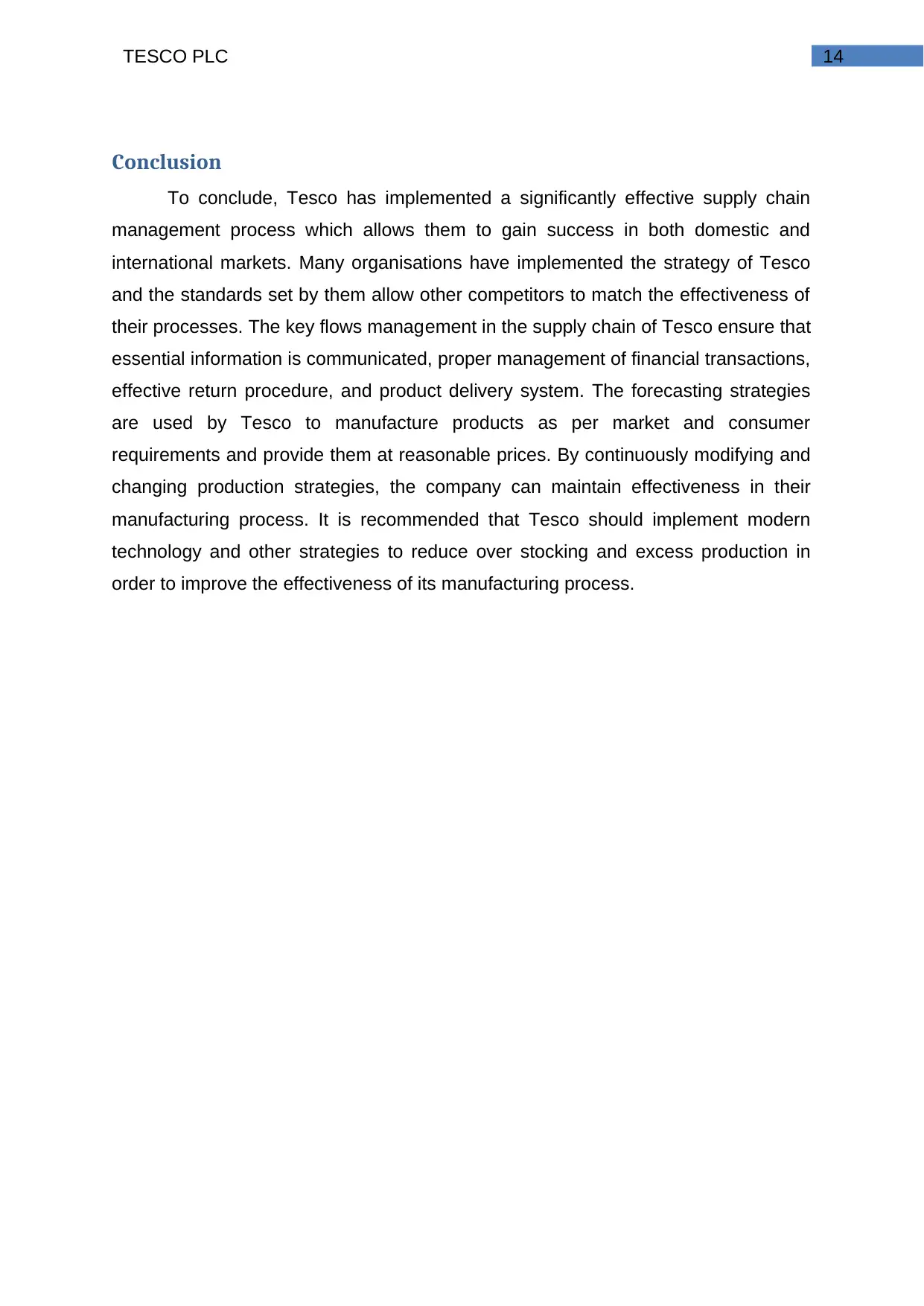
14TESCO PLC
Conclusion
To conclude, Tesco has implemented a significantly effective supply chain
management process which allows them to gain success in both domestic and
international markets. Many organisations have implemented the strategy of Tesco
and the standards set by them allow other competitors to match the effectiveness of
their processes. The key flows management in the supply chain of Tesco ensure that
essential information is communicated, proper management of financial transactions,
effective return procedure, and product delivery system. The forecasting strategies
are used by Tesco to manufacture products as per market and consumer
requirements and provide them at reasonable prices. By continuously modifying and
changing production strategies, the company can maintain effectiveness in their
manufacturing process. It is recommended that Tesco should implement modern
technology and other strategies to reduce over stocking and excess production in
order to improve the effectiveness of its manufacturing process.
Conclusion
To conclude, Tesco has implemented a significantly effective supply chain
management process which allows them to gain success in both domestic and
international markets. Many organisations have implemented the strategy of Tesco
and the standards set by them allow other competitors to match the effectiveness of
their processes. The key flows management in the supply chain of Tesco ensure that
essential information is communicated, proper management of financial transactions,
effective return procedure, and product delivery system. The forecasting strategies
are used by Tesco to manufacture products as per market and consumer
requirements and provide them at reasonable prices. By continuously modifying and
changing production strategies, the company can maintain effectiveness in their
manufacturing process. It is recommended that Tesco should implement modern
technology and other strategies to reduce over stocking and excess production in
order to improve the effectiveness of its manufacturing process.
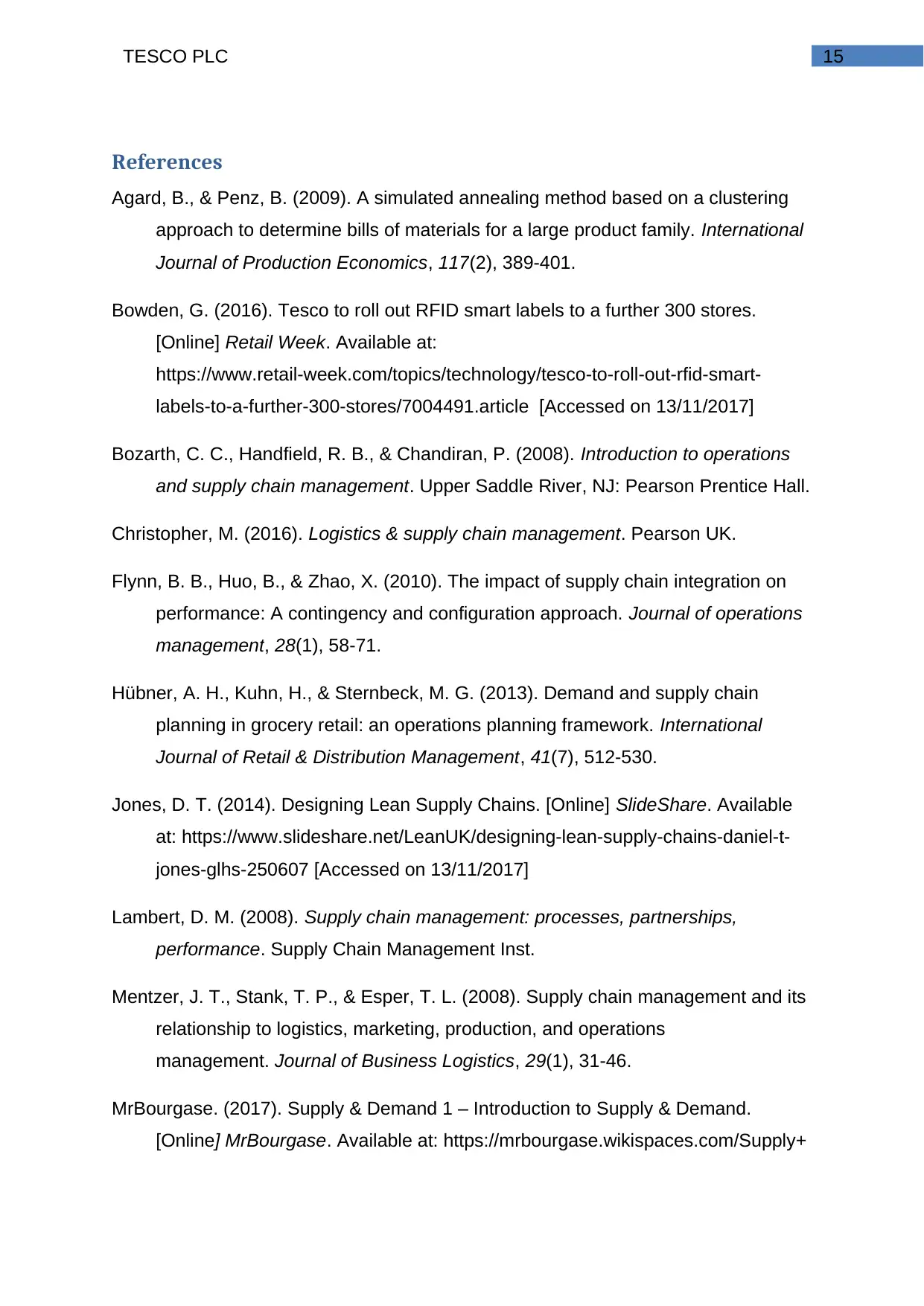
15TESCO PLC
References
Agard, B., & Penz, B. (2009). A simulated annealing method based on a clustering
approach to determine bills of materials for a large product family. International
Journal of Production Economics, 117(2), 389-401.
Bowden, G. (2016). Tesco to roll out RFID smart labels to a further 300 stores.
[Online] Retail Week. Available at:
https://www.retail-week.com/topics/technology/tesco-to-roll-out-rfid-smart-
labels-to-a-further-300-stores/7004491.article [Accessed on 13/11/2017]
Bozarth, C. C., Handfield, R. B., & Chandiran, P. (2008). Introduction to operations
and supply chain management. Upper Saddle River, NJ: Pearson Prentice Hall.
Christopher, M. (2016). Logistics & supply chain management. Pearson UK.
Flynn, B. B., Huo, B., & Zhao, X. (2010). The impact of supply chain integration on
performance: A contingency and configuration approach. Journal of operations
management, 28(1), 58-71.
Hübner, A. H., Kuhn, H., & Sternbeck, M. G. (2013). Demand and supply chain
planning in grocery retail: an operations planning framework. International
Journal of Retail & Distribution Management, 41(7), 512-530.
Jones, D. T. (2014). Designing Lean Supply Chains. [Online] SlideShare. Available
at: https://www.slideshare.net/LeanUK/designing-lean-supply-chains-daniel-t-
jones-glhs-250607 [Accessed on 13/11/2017]
Lambert, D. M. (2008). Supply chain management: processes, partnerships,
performance. Supply Chain Management Inst.
Mentzer, J. T., Stank, T. P., & Esper, T. L. (2008). Supply chain management and its
relationship to logistics, marketing, production, and operations
management. Journal of Business Logistics, 29(1), 31-46.
MrBourgase. (2017). Supply & Demand 1 – Introduction to Supply & Demand.
[Online] MrBourgase. Available at: https://mrbourgase.wikispaces.com/Supply+
References
Agard, B., & Penz, B. (2009). A simulated annealing method based on a clustering
approach to determine bills of materials for a large product family. International
Journal of Production Economics, 117(2), 389-401.
Bowden, G. (2016). Tesco to roll out RFID smart labels to a further 300 stores.
[Online] Retail Week. Available at:
https://www.retail-week.com/topics/technology/tesco-to-roll-out-rfid-smart-
labels-to-a-further-300-stores/7004491.article [Accessed on 13/11/2017]
Bozarth, C. C., Handfield, R. B., & Chandiran, P. (2008). Introduction to operations
and supply chain management. Upper Saddle River, NJ: Pearson Prentice Hall.
Christopher, M. (2016). Logistics & supply chain management. Pearson UK.
Flynn, B. B., Huo, B., & Zhao, X. (2010). The impact of supply chain integration on
performance: A contingency and configuration approach. Journal of operations
management, 28(1), 58-71.
Hübner, A. H., Kuhn, H., & Sternbeck, M. G. (2013). Demand and supply chain
planning in grocery retail: an operations planning framework. International
Journal of Retail & Distribution Management, 41(7), 512-530.
Jones, D. T. (2014). Designing Lean Supply Chains. [Online] SlideShare. Available
at: https://www.slideshare.net/LeanUK/designing-lean-supply-chains-daniel-t-
jones-glhs-250607 [Accessed on 13/11/2017]
Lambert, D. M. (2008). Supply chain management: processes, partnerships,
performance. Supply Chain Management Inst.
Mentzer, J. T., Stank, T. P., & Esper, T. L. (2008). Supply chain management and its
relationship to logistics, marketing, production, and operations
management. Journal of Business Logistics, 29(1), 31-46.
MrBourgase. (2017). Supply & Demand 1 – Introduction to Supply & Demand.
[Online] MrBourgase. Available at: https://mrbourgase.wikispaces.com/Supply+
Secure Best Marks with AI Grader
Need help grading? Try our AI Grader for instant feedback on your assignments.
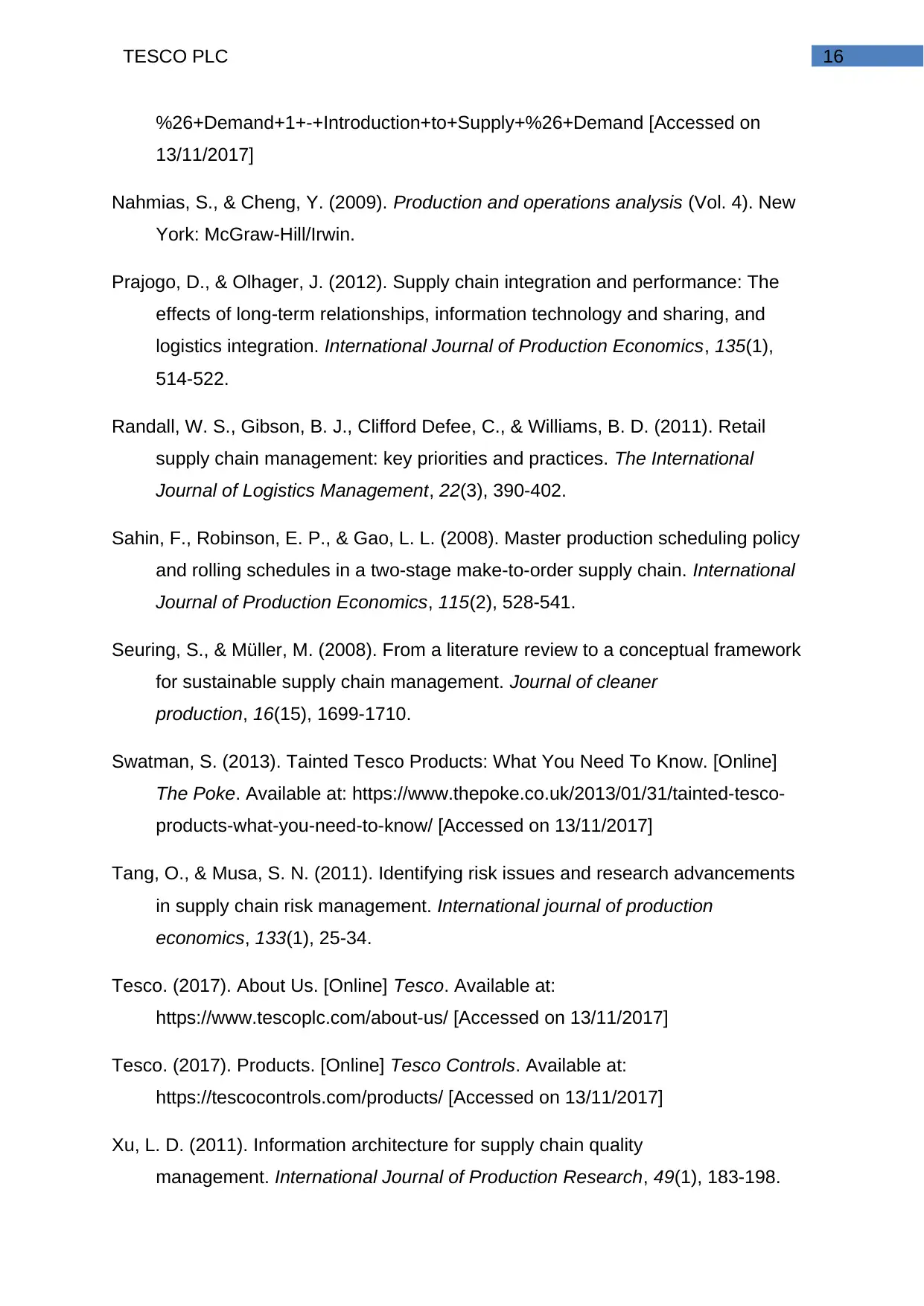
16TESCO PLC
%26+Demand+1+-+Introduction+to+Supply+%26+Demand [Accessed on
13/11/2017]
Nahmias, S., & Cheng, Y. (2009). Production and operations analysis (Vol. 4). New
York: McGraw-Hill/Irwin.
Prajogo, D., & Olhager, J. (2012). Supply chain integration and performance: The
effects of long-term relationships, information technology and sharing, and
logistics integration. International Journal of Production Economics, 135(1),
514-522.
Randall, W. S., Gibson, B. J., Clifford Defee, C., & Williams, B. D. (2011). Retail
supply chain management: key priorities and practices. The International
Journal of Logistics Management, 22(3), 390-402.
Sahin, F., Robinson, E. P., & Gao, L. L. (2008). Master production scheduling policy
and rolling schedules in a two-stage make-to-order supply chain. International
Journal of Production Economics, 115(2), 528-541.
Seuring, S., & Müller, M. (2008). From a literature review to a conceptual framework
for sustainable supply chain management. Journal of cleaner
production, 16(15), 1699-1710.
Swatman, S. (2013). Tainted Tesco Products: What You Need To Know. [Online]
The Poke. Available at: https://www.thepoke.co.uk/2013/01/31/tainted-tesco-
products-what-you-need-to-know/ [Accessed on 13/11/2017]
Tang, O., & Musa, S. N. (2011). Identifying risk issues and research advancements
in supply chain risk management. International journal of production
economics, 133(1), 25-34.
Tesco. (2017). About Us. [Online] Tesco. Available at:
https://www.tescoplc.com/about-us/ [Accessed on 13/11/2017]
Tesco. (2017). Products. [Online] Tesco Controls. Available at:
https://tescocontrols.com/products/ [Accessed on 13/11/2017]
Xu, L. D. (2011). Information architecture for supply chain quality
management. International Journal of Production Research, 49(1), 183-198.
%26+Demand+1+-+Introduction+to+Supply+%26+Demand [Accessed on
13/11/2017]
Nahmias, S., & Cheng, Y. (2009). Production and operations analysis (Vol. 4). New
York: McGraw-Hill/Irwin.
Prajogo, D., & Olhager, J. (2012). Supply chain integration and performance: The
effects of long-term relationships, information technology and sharing, and
logistics integration. International Journal of Production Economics, 135(1),
514-522.
Randall, W. S., Gibson, B. J., Clifford Defee, C., & Williams, B. D. (2011). Retail
supply chain management: key priorities and practices. The International
Journal of Logistics Management, 22(3), 390-402.
Sahin, F., Robinson, E. P., & Gao, L. L. (2008). Master production scheduling policy
and rolling schedules in a two-stage make-to-order supply chain. International
Journal of Production Economics, 115(2), 528-541.
Seuring, S., & Müller, M. (2008). From a literature review to a conceptual framework
for sustainable supply chain management. Journal of cleaner
production, 16(15), 1699-1710.
Swatman, S. (2013). Tainted Tesco Products: What You Need To Know. [Online]
The Poke. Available at: https://www.thepoke.co.uk/2013/01/31/tainted-tesco-
products-what-you-need-to-know/ [Accessed on 13/11/2017]
Tang, O., & Musa, S. N. (2011). Identifying risk issues and research advancements
in supply chain risk management. International journal of production
economics, 133(1), 25-34.
Tesco. (2017). About Us. [Online] Tesco. Available at:
https://www.tescoplc.com/about-us/ [Accessed on 13/11/2017]
Tesco. (2017). Products. [Online] Tesco Controls. Available at:
https://tescocontrols.com/products/ [Accessed on 13/11/2017]
Xu, L. D. (2011). Information architecture for supply chain quality
management. International Journal of Production Research, 49(1), 183-198.
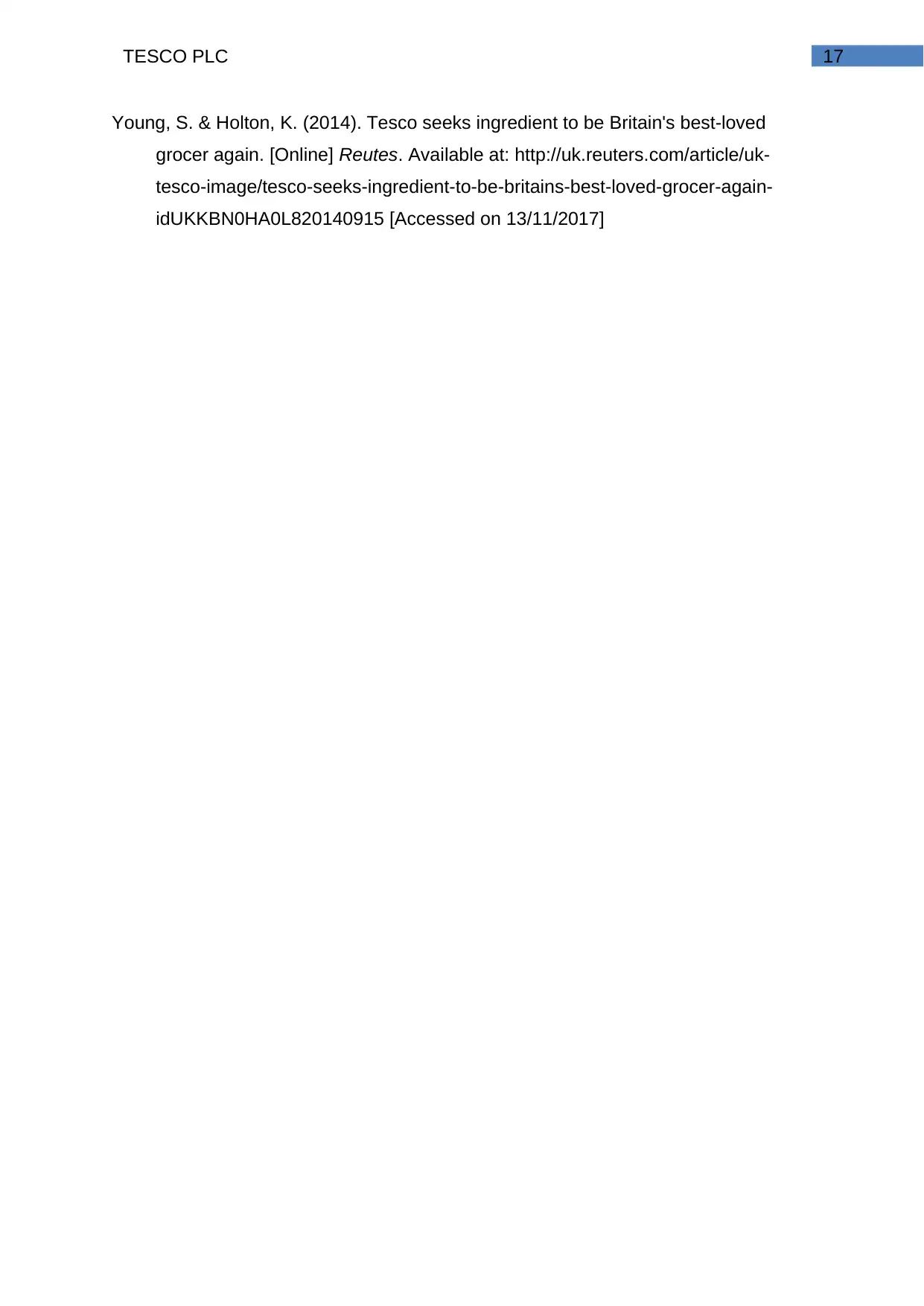
17TESCO PLC
Young, S. & Holton, K. (2014). Tesco seeks ingredient to be Britain's best-loved
grocer again. [Online] Reutes. Available at: http://uk.reuters.com/article/uk-
tesco-image/tesco-seeks-ingredient-to-be-britains-best-loved-grocer-again-
idUKKBN0HA0L820140915 [Accessed on 13/11/2017]
Young, S. & Holton, K. (2014). Tesco seeks ingredient to be Britain's best-loved
grocer again. [Online] Reutes. Available at: http://uk.reuters.com/article/uk-
tesco-image/tesco-seeks-ingredient-to-be-britains-best-loved-grocer-again-
idUKKBN0HA0L820140915 [Accessed on 13/11/2017]
1 out of 18
Related Documents
Your All-in-One AI-Powered Toolkit for Academic Success.
+13062052269
info@desklib.com
Available 24*7 on WhatsApp / Email
![[object Object]](/_next/static/media/star-bottom.7253800d.svg)
Unlock your academic potential
© 2024 | Zucol Services PVT LTD | All rights reserved.





